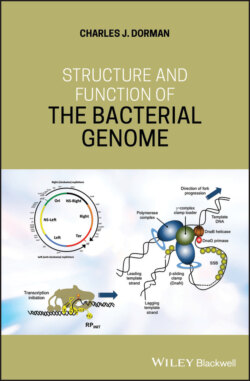Читать книгу Structure and Function of the Bacterial Genome - Charles J. Dorman - Страница 39
1.28 DNA Topoisomerases: DNA Gyrase
ОглавлениеTopoisomerases are classed as type I if they change the linking number of DNA in steps of one, and as type II if the linking number changes in steps of two (Champoux 2001; Wang 2002) (Table 1.1). DNA gyrase is a type II enzyme and it has the property, unique to prokaryotes, of being able to introduce negative supercoils into DNA (Gellert et al. 1976a; Higgins et al. 1978; Nöllmann et al. 2007). This negative supercoiling activity is ATP dependent and there is an ATP‐binding site in the B subunit of gyrase (Gellert et al. 1979; Mizuuchi et al. 1978). Gyrase is an A2B2 hetero‐tetramer and it is essential; knockout mutations in either of the genes that encode its A (gyrA) or B (gyrB) subunits are lethal (Bates and Maxwell 2005). Its essentiality has made gyrase a very attractive target for antimicrobial therapy and a number of drugs are available that target its subunits (Collin et al. 2011; Maxwell 1999). The coumarin class of antimicrobials have been particularly useful as research tools because they compete with ATP for access to the B subunit ATPase and inhibit gyrase activity without inducing the SOS response (DeMarini and Lawrence 1992; Gellert et al. 1976b; Gormley et al. 1996; Pugsley 1981; Sugino and Cozzarelli 1980; Sugino et al. 1978). In contrast, those drugs (e.g. quinolones) that inhibit the A subunit during DNA cleavage and religation cause DNA damage that results in induction of the SOS response (Gellert et al. 1977), something that can complicate experimental design and data interpretation. Gyrase also has an ATP‐independent DNA relaxing activity that is unmasked only in the absence of ATP (Gellert et al. 1977; Higgins et al. 1978; Williams and Maxwell 1999). The ATP‐dependent mechanism by which gyrase introduces negative supercoils into DNA is also capable of relaxing positive supercoils (Ashley et al. 2017). This activity is especially important when gyrase processes the positively supercoiled DNA that is a by‐product of transcription and DNA replication (Koster et al. 2010) (Figures 1.14 and 1.15). DNA gyrase in living cells responds to the [ATP]/[ADP] ratio, linking the management of DNA topology to the metabolic activity of the bacterium (Hsieh et al. 1991a,b; Snoep et al. 2002; van Workum et al. 1996). Gyrase activity is also tuned in living bacteria by stresses such as the acidification of the bacterial cytosol that accompanies adaptation to acid stress (Colgan et al. 2018).
